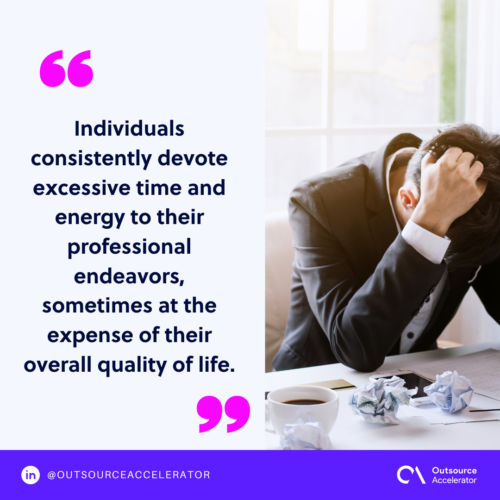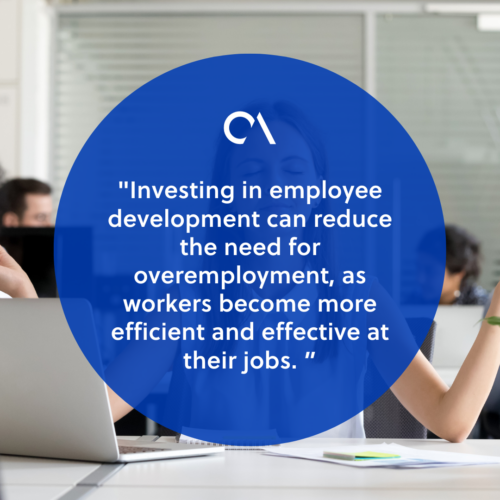Overemployment: When more isn’t always better

Today’s world sees more and more people finding themselves grappling with the lesser-known phenomenon of overemployment.
While the concepts of unemployment and underemployment rightfully dominate discussions about the labor market, overemployment receives far less attention. However, one can argue that it is equally critical.
Technology has blurred the boundaries between work and personal life. Additionally, societal pressures demand ever-increasing levels of productivity, resulting in overemployment becoming a serious issue that needs to be addressed.
This article will dive into the complexities of overemployment, exploring its causes, effects, and strategies to mitigate it.
What is overemployment?
Overemployment is a condition where individuals are engaged in work to an excessive degree. This means it can go beyond what is necessary for financial stability or personal fulfillment.
Overemployment is characterized by an overwhelming preoccupation with work. Individuals consistently devote excessive time and energy to their professional endeavors, sometimes at the expense of their overall quality of life.
The phenomenon is becoming increasingly prevalent in today’s workforce because of a number of factors. It often leads to burnout, stress, and a diminished sense of satisfaction.

Effects of overemployment
Here are some of the effects of overemployment:
- Impact on overall well-being – It often comes at the expense of personal well-being and fulfillment.
- Physical and mental health issues – This can lead to chronic stress, which increases the risk of more serious health conditions.
- Strain on relationships – Overemployed individuals may struggle to balance time with loved ones, leading to isolation and loneliness.
- Decreased productivity and quality – Working excessively long hours can result in diminishing returns in terms of productivity and the quality of work.
- Job dissatisfaction and reduced engagement – Overemployment can erode job satisfaction and reduce overall engagement due to people working beyond their capacity.
- Increased risk of accidents and errors – Fatigue resulting from overemployment can increase the likelihood of workplace accidents and errors.
- Economic consequences – The long-term economic consequences of overemployment can be detrimental, including increased healthcare costs, decreased earning potential, and job loss.
Causes of overemployment
Overemployment can stem from various factors within both individual and societal contexts.
Some of the primary causes include:
Demand-supply imbalance
One of the key factors driving overemployment is the demand-supply imbalance in the labor market.
This occurs when the demand for workers exceeds the supply of qualified candidates. In February 2023, FRED Economic Data reported that there were 4.7 million more jobs than available workers.
It leads to a situation in which existing employees need to work longer hours to compensate for the shortage.

Culture of overwork
Whether it’s on a societal or organizational level, we may occasionally create cultures that value employees who work long hours, which contributes to overemployment.
Many times, this is equated with dedication, commitment, and achievement. Thus, individuals feel reassured to work excessively to meet those standards and expectations.
Additionally, a culture like this can cultivate certain personality traits in others. Perfectionism, workaholism, and a strong need for achievement can predispose people to overemployment.
Technology and connectivity
The advent of technology has blurred the boundaries between professional and personal life. Constant connectivity through smartphones and remote work platforms has made it difficult for people to disconnect from work.
This can lead to employees feeling like they need to be responsive to work even when they are off the clock.
Financial needs
If you’re struggling financially, you may be more likely to take on multiple jobs or work longer hours to make ends meet.
Rising living costs, stagnant wages, and the need to meet financial obligations can contribute to overemployment.
Inflexible work policies and practices
In some cases, overemployment can result from inefficient work practices. This could be due to outdated work practices, lack of automation, or insufficient staffing resources.
Lack of social support
Limited access to social support networks, including childcare, eldercare, and community resources, can exacerbate the pressures of overemployment.
These include:
- Childcare
- Eldercare
- Community resources
Without adequate support systems in place, individuals may feel compelled to shoulder the burden of work responsibilities alone, leading to increased stress and burnout.
Globalization and competition
A globalized economy brings fierce competition for jobs and opportunities. Fear of job loss or being left behind can drive people to overwork in an effort to stay competitive, acquire new skills, or advance their careers.
Strategies for tackling overemployment
Companies play a crucial role in addressing overemployment and promoting a healthier work-life balance for their employees.
Here are several strategies that companies can implement to help lessen overemployment:
Prioritize employee well-being
Cultivate a company culture that prioritizes its employees health and well-being. You can provide support and resources for stress management, mental health care, and healthy lifestyle choices.
These can be done by offering the following:
- Employee assistance programs (EAPs)
- Wellness initiatives
- Paid time off
Monitor workload and workflows
Implement systems to monitor employee workload and identify potential bottlenecks or inefficiencies.
Firstly, ensure that staffing levels are adequate and that workloads are reasonable. This might involve hiring additional staff or redistributing workloads.
You can also identify areas where automation can improve workflow and reduce the time needed to complete tasks.
Offer flexible work arrangements
Allow employees to work flexibly by offering telecommuting options, flexible schedules, and opportunities for remote work. This can reduce the need for excessive overtime and support a better work-life balance.
Provide training and education
Provide training and development to enhance employee skills and productivity. Investing in employee development can reduce the need for overemployment, as workers become more efficient and effective at their jobs.

Conduct performance reviews and give incentives
Conduct regular performance reviews to identify areas where employees may need additional support and training. Also, recognize employees for their hard work and contributions.
This will reduce the need for excessive work hours to prove oneself. Employees who feel valued and appreciated are more likely to maintain a healthy work-life balance.
Encourage work boundaries
Encourage employees to set boundaries around their work hours, availability, and communication preferences. It will help prevent work from creeping into their personal time.
Managers and supervisors should respect these boundaries and refrain from work-related contact unless necessary.
Promote self-care
On the individual level, encourage employees to make time for their own self-care activities. These may include exercise, hobbies, or spending time with loved ones to help mitigate the effects of stress and burnout.
Overemployment represents a nuanced challenge in today’s workforce landscape. By fostering environments that value quality over quantity, we can strive toward a healthier, more fulfilling work culture for individuals and communities alike.







 Independent
Independent




